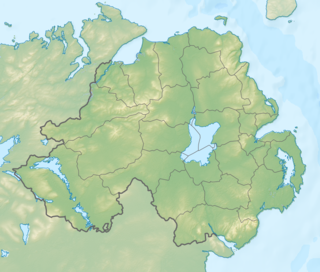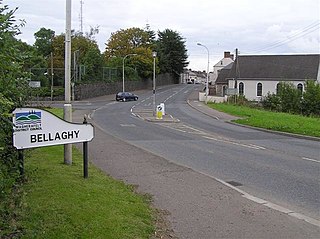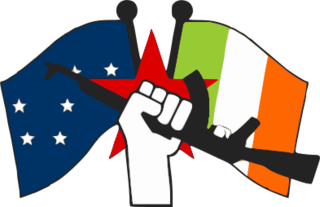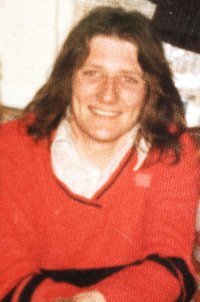
The East Tyrone Brigade of the Provisional Irish Republican Army (IRA), also known as the Tyrone/Monaghan Brigade was one of the most active republican paramilitary groups in Northern Ireland during "the Troubles". It is believed to have drawn its membership from across the eastern side of County Tyrone as well as north County Monaghan and south County Londonderry.

The Irish People's Liberation Organisation was a small Irish republican paramilitary organisation which was formed in 1986 by disaffected and expelled members of the Irish National Liberation Army (INLA) whose factions coalesced in the aftermath of the supergrass trials. It developed a reputation for intra-republican and sectarian violence and criminality, before being forcibly disbanded by the Provisional Irish Republican Army (IRA) in 1992.
Dominic McGlinchey was a Republican who moved from the Provisional IRA to become head of the Irish National Liberation Army (INLA), an Irish republican paramilitary group. Although active in attacks on British security forces, McGlinchy's indiscriminate ruthlessness led to him being the first Republican extradited from Ireland. An internecine conflict centred around McGlinchey and a rebellious faction he had attempted to impose his authority on greatly weakened the INLA and he was shot dead in a revenge attack in 1994.
This is a chronology of activities by the Provisional Irish Republican Army (IRA) from 1970 to 1979. For actions after this period see Chronology of Provisional Irish Republican Army actions.
The Troubles in Garvagh recounts incidents during, and the effects of, The Troubles in Garvagh, County Londonderry, Northern Ireland.
This is a timeline of actions by the Irish National Liberation Army (INLA), an Irish republican socialist paramilitary group. Most of these actions took place as part of its 1975–1998 campaign during "the Troubles" in Northern Ireland. The INLA did not start claiming responsibility for its actions under the INLA name until January 1976 at which point they had already killed 12 people, before then they used the names People's Liberation Army(PLA) & People's Republican Army(PRA) to claim its attacks.
This is a chronology of activities by the Provisional Irish Republican Army (IRA) from 1980 to 1989. For actions before and after this period see Chronology of Provisional Irish Republican Army actions.

The 1991 Cappagh killings was a gun attack by the loyalist Ulster Volunteer Force (UVF) on 3 March 1991 in the village of Cappagh, County Tyrone, Northern Ireland. A unit of the UVF's Mid-Ulster Brigade drove to the staunchly republican village and shot dead three Provisional IRA volunteers and a Catholic civilian at Boyle's Bar.
The Troubles in Ardoyne lists incidents during the Troubles in the Ardoyne district of Belfast, Northern Ireland.

The Ballygawley land mine attack was a bomb attack carried out by the Provisional Irish Republican Army (PIRA) on the 13 July 1983. The IRA exploded a landmine under an Ulster Defense Regiment's (UDR) mobile patrol at Ballygawley Road, near Dungannon in County Tyrone, Northern Ireland. Four UDR soldiers were killed in the incident.

On 11 August 1970, two Royal Ulster Constabulary (RUC) officers were killed by a booby-trap bomb planted under a car by the Provisional Irish Republican Army (IRA) near Crossmaglen, in County Armagh, Northern Ireland. They were the first RUC officers to be killed by republicans during the Troubles and the first security forces to be killed in South Armagh, an IRA stronghold for much of the conflict.
The following is a timeline of Northern Irish conflict actions which took place in the Republic of Ireland between 1969 and 1998. It includes Ulster Volunteer Force bombings such as the Dublin and Monaghan bombings in May 1974, and other Loyalist bombings, the last of which was in 1997. These attacks killed dozens of people. Actions by Irish Republicans include deadly bombings, prison escapes, kidnappings, and gun battles between the Gardaí (police) and the Irish Defence Forces against Republican gunmen from the Irish National Liberation Army, the Provisional Irish Republican Army, and a socialist-revolutionary group, Saor Éire. These attacks killed a number of civilians, police, soldiers, and Republican terrorists.

The 1991 Craigavon killings took place on the 14 November 1991 when the Mid-Ulster Brigade of the Ulster Volunteer Force (UVF) shot dead three civilians at the Carbet Road-Carn Road junction near Craigavon, County Armagh, Northern Ireland, on their way home from work at a forklift factory just outside Lurgan.
The Irish National Liberation Army Belfast Brigade was the main brigade area of the Irish National Liberation Army. The other Brigade areas were in Derry and Armagh with smaller units in Newry, east and west Tyrone and south Fermanagh.

The Dungannon land mine attack was a IED bombing and shooting against a British Army mobile patrol. The attack was carried out by IRA volunteers from the Provisional IRA's (PIRA) East Tyrone Brigade on 16 December 1979, along the Ballygawley Road, just outside Dungannon in County Tyrone. Four British soldiers who were on mobile patrol were killed in the ambush.

On 4 September 1985, the Provisional IRA fired mortar bombs at a Royal Ulster Constabulary (RUC) base and training centre in Enniskillen, County Fermanagh. Nobody was killed, but 30 people were injured in the attack and the base, which was mainly used to train new recruits, was very badly damaged. The IRA hoped to repeat the success they had earlier in the year when Newry RUC station was attacked with mortars and nine RUC officers were killed and almost 40 injured. It was one of numerous IRA mortar attacks on British Army and RUC bases around this time period.
This is a timeline of actions by the Official Irish Republican Army, an Irish republican & Marxist-Leninist paramilitary group. Most of these actions took place as part of a Guerrilla campaign against the British Army & Royal Ulster Constabulary and internal Irish Republican feuds with the Provisional IRA & Irish National Liberation Army from the early 1970s - to the mid 1970s during the most violent phase of "the Troubles" in Northern Ireland.
The following is a Timeline of British Amy & Police undercover operations during Operation Banner during the 1969 - 1998 Northern Irish conflict in Northern Ireland that resulted in death or injury. Including operations by the SAS, 14 Intelligence Company, the Military Reaction Force (MRF) & RUC Special Patrol Group & Special Branch. (Any help to fill in missing spaces is greatly aappreciated.)











